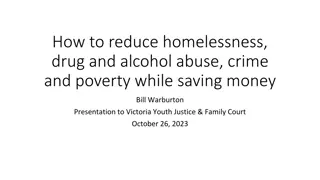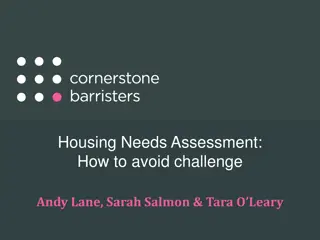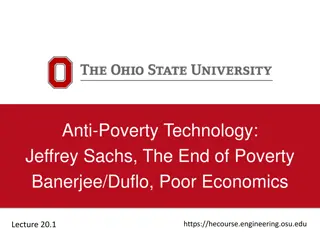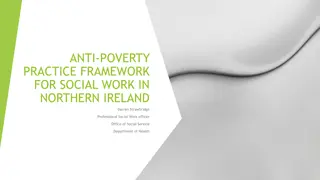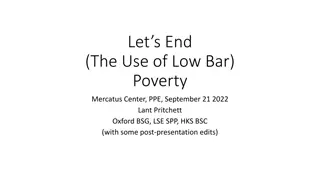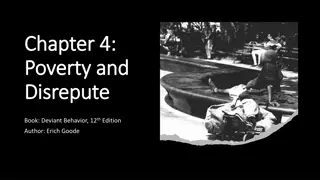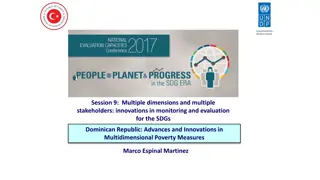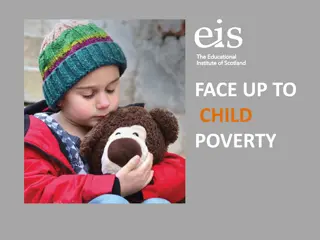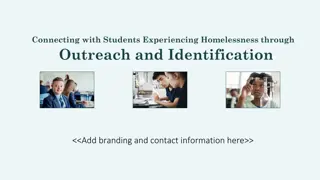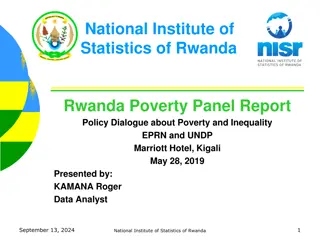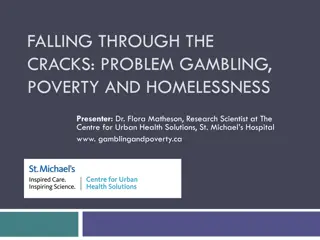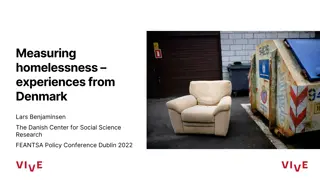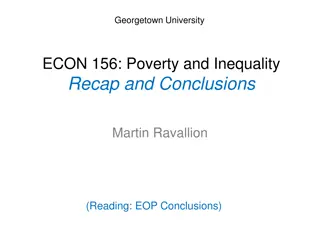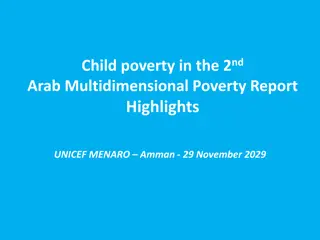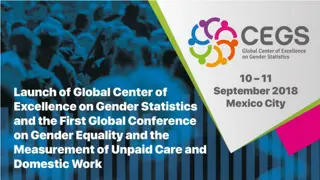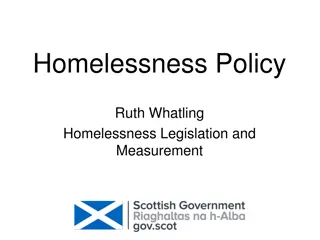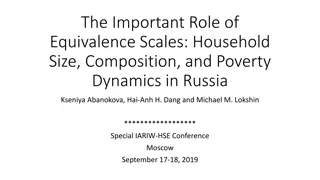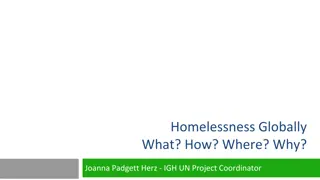Understanding Populations in Homelessness and Poverty Presentation
This presentation by the Community Transportation Association of the Northwest, presented by Ryan Acker, delves into the importance of understanding homelessness and poverty. It highlights the challenges faced by vulnerable populations, such as homeless individuals, those living in poverty, people with disabilities, veterans, seniors, and those with mental health conditions. The presentation emphasizes the need for compassionate and effective customer service to address the specialized transportation needs of these populations. It also aims to break down myths and misconceptions surrounding homelessness and poverty, advocating for a better understanding of the impact on individuals. Featuring insights on Maslow's Hierarchy of Needs, the presentation underscores the fundamental requirements for individuals to thrive and feel secure.
Download Presentation

Please find below an Image/Link to download the presentation.
The content on the website is provided AS IS for your information and personal use only. It may not be sold, licensed, or shared on other websites without obtaining consent from the author. Download presentation by click this link. If you encounter any issues during the download, it is possible that the publisher has removed the file from their server.
E N D
Presentation Transcript
Homelessness & Poverty: Understanding Populations We Work With A presentation from Community Transportation Association of the Northwest Presented by Ryan Acker, Executive Director
WARNING WARNING This presentation contains adult-oriented language.
Why is understanding homelessness and poverty important? Community and specialized transportation services are designed for people with specialized transportation needs, including those who because of age, income or ability, are unable to transport or provide transportation for themselves. Homeless populations and people living in poverty are among the most vulnerable in our communities. Within the homeless and lower- income communities, there are many other people who can face accessibility challenges, including people with disabilities, veterans, seniors, and people living with a mental health condition.
At the Crossroads Homelessness, Poverty and Community and Specialized Transportation Customer service Service coordination Policies
Customer Service Compassionate, effective, professional services To do that, we need to understand the populations we re serving
Customer Service Breaking down myths, negative attitudes and misconceptions Understanding the impact of homelessness and poverty on people The bottom line
What are some common beliefs you ve heard about people who are homeless or living in poverty?
Maslows Hierarchy of Needs: Think about these as we go through Physical: (Hope), Air, (Immediate Medical), Shelter, Water, Food, Gratification The Rule of 3 Sense of Security: Predictability, Reliability (this is how the transportation systems able to work), Trust I feel safe when . Reasonable Expectations. Love, Belonging, Community: Being a part of something, friends, family, community, job Self-Esteem: Sense of own self worth, direction Self-Actualization: I ve got this! Thriving
Shelter Often as a result of issues in other areas Sense of Security Shelter Why it 3 hours?
When someone becomes homeless When someone becomes homeless You have to consider that by the time someone loses their own home, they have exhausted all of their options. 3 days is how long it takes to decompensate: Sense of Security is Breaking Down Changes the Way We Operate SURVIVAL MODE
How many people like pooping in public? Human bodies pee and poop. We learn to control that, and we develop modesty as part of civilized society .
You need to know When a person is at a place where they must poop outside they have had to surrender a part of themselves; It is humiliating; It is survival.
Homeless People are Lazy!
How many people have ever had a toothache? Your brain starts a loop.
Think back to a time when you moved Stressful, yes? Unpack Get the cable, phone Where am I going to do my laundry? Where s the closest store? Brain loop Question, decisions About 6 months to a year What if you had to move/process that EVERY SINGLE DAY: I don t know where I m going to sleep tonight I don t where I m going to pee in the next three hours I m on my period and I don t know where I m going to get pads It is a continuous false start. Cannot get feet planted. I can t think about anything further, because I don t have this very basic need met.
It takes a LOT of energy to be In Survival Mode To be homeless To be living in poverty
Write this down! This is harder than it looks.
With your dominant hand, snap Every time you snap, this is something that you need, but you don t have With you non-dominant hand
Some People Choose to Be Homeless Why are there more homeless people in Washington and Oregon? Ohio Funding specifically for homeless programs and mental health programs; Taxes directed towards those Friends, family You know people are going to die. The weather is nice in WA/OR Coastal areas But do these people choose to be homeless? Never: 1) Human beings make decisions-based on the information available to them at the time of the decision. 2) Can seem to be better options based on information and opportunities available; 3) False Options
Love, Sense of security community, belonging What might seem like benefits? Cycle that s temporary (not thriving) Independence (Self-Esteem) Life centered around stopping the snapping
Ive seen people on food stamps with cell I ve seen people on food stamps with cell phones, nice shoes and a big screen tv! phones, nice shoes and a big screen tv! Individual circumstances Prized possession Gift/opportunities People help how they can Basic Needs Belief that people should suffer/Doesn t meet expectations of what poverty looks like Comparing unknown apples to unknown oranges
How many people use any of the following? Coffee Soda Sugar Cigarettes Alcohol Prescription medications These are all substances
$3.00 Today s list (View from a helper ) Out of toothpaste/toothbrush (.50) Out of toilet paper (.98) Need to find a place to sleep tonight Can t find ID Need to get a new one ($20.00) Have to get across town (food pantry); need a bus pass ($1.25) Would really like a soda/beer/candy bar (@1.98) Decisions: Auto Pilot Essential to immediate survival? Which of these will bring me joy? Causes me stress? Can I handle the stress?
Not true So what? Causing factor versus coping mechanism Shelter is a foundational basic human need; Hard to address mental, emotional, behavioral health issues when basic needs not met. Drug addiction is between the person and their addiction. Homeless people are drug addicts There is nothing noble in being superior to your fellow man; true nobility is being superior to your former self. Ernest Hemingway Expectation for homeless people or people in poverty to have super-human coping mechanisms
Impacts Cycle of catch-up versus preventative It costs A LOT to be poor Impact on mental, emotional and physical health Higher rates, late fees No credit Government paperwork Dental/physical health Bills Housing Impact on meeting basic needs + future goals Student loans/past debts It takes a long time.
Shrinks time-frame of decision- making Minute-to-minute Day-to-day SAVINGS? Hoarding Impacts Emphasized Prioritization Kids Certain material things Changes behavior Can become a driving force/fixation
Impacts Impacts relationships Isolation Diminished boundaries Self-exploitation Manipulation Coercion Anger Explosive
Need to know Person is NOT operating at highest and fullest potential; But they are doing the best that they can at this moment.
3 Days to decompensate 3 Years to restore
Hope Access to basic needs Getting from point A to point B Friends, family as important as medical care and social services and jobs In Customer Service Affirmation of dignity and worth and respect as a human being How you speak to the person How you interact Everyone is a VIP Information Clear expectations Transparency Opportunity
Service Coordination 01 02 03 Community and specialized transportation providers are a part of the safety net; Cannot control other portions I.E. homeless services, health care, food stamps CAN influence
What are some services you think a person who is homeless or living in Poverty Might need
What are some services you think a person who is homeless or living in Poverty Might need Shelter/Low-Income Housing Court house/probation Grocery/food Hospital Mental Health Facilities Department of Human Service (I.E. Food benefits, social security income, Social Security Office Jobs College/Education Clothing Store
Need you at that table There will sometimes be people at a table who will say they re just a bunch of drug addicts or they re just a bunch of crazies . It s offensive and it s a lie. And it strips people of their dignity and worth. They need you to stand up for them, because right now, they can t stand up for themselves or else they wouldn t be in the position they are in. Homeless people in your community
Why are people homeless? Domestic Violence Suddenly lost job/income (can easily get another one or more soon) Mental health condition impacts ability to work, emotional stability, ability to form relationships (CAN BE THE CAUSE OR HAPPEN BECAUSE OF) Addiction impacts prioritization No friends, family, support Physical abilities or health impacts ability to earn meaningful income Housing prices too high Criminal background makes it challenging to meet financial/housing needs Transportation makes it challenging to meet housing/work needs Support network unable to provide enough support for person Knowing your stuff
Did you know? Disparately impacted communities: LGBT (up to 40% of homeless youth), Veterans (13%), People with Mental Health Condition (up to 25%), Isolated individuals, People who have faced discrimination (Black/African American Up to 38%)), trauma There is a loss (or never was); Trauma that impacted their Maslow s Social services intervention can sometimes only focuses on one or two issues Not the underlying factors. Housing First/Medical First/Employment First/Transportation First It needs to be integrated. Individualized Assessments must be individualized; Intervention must be appropriate and address issues. Knowing your stuff
Gravity Intervention Service Coordination We are all front line We have power
Siting of facilities, routes and services How are they going to get there? Accessibility, availability and affordability of transportation Fee waivers? Links to other services (as identified) Coordinated services and efforts benefits all people MOU s with shelter, food, medical, mental health and social services Training front-line staff To Do s
We CAN control own policies Human-Centered Policies in Transportation Policies
ID Cards Fee waivers Sleeping on Transit Public restrooms Congregation Anger/Disruptive Behavior Enforcement discretion Policies
Rationale for policy Applied Equally How would you treat a person who appeared to be a college student who nodded off? Or a business person on their way to the airport? Enforcement discretion/Protocol I.E. Provide tools/resources Set-up a partnership with a shelter specifically MOU to make your passengers a priority Drop-off at shelter end of trip? Kindness, fairness, sound rationale and policy Sleeping on Transit/Bus Stops
Public/private partnerships Reasons for having it; Worth the investment Alternatives Disease Death Kindness, fairness, sound rationale and policy Unnamed Department Store Public restrooms
Okay Its a bus stop Behaviors prohibited Harassment Violence Talking to people??? Congregation
Anger/Disruptive Behavior I need a volunteer who wants to cuss!
Desperation = Raised Voice = Fighting Words I am in pain And I don t know what to do about it I am not getting my needs met, and I don t know how I am fighting for me, because no one else will I m signaling my boundaries (I don t like your shoes) I ve run out of ways to communicate Remain calm It s not about you (if it is, address that) Empower people: Affirmation, information, opportunity. De-escalate/re- direct. And affirm personal and agency boundaries. Red = listen to Blue = human interaction (we can all do better)
Recognize/honor human emotions and conditions; Also recognize and respect those in service/employment. Policies that



